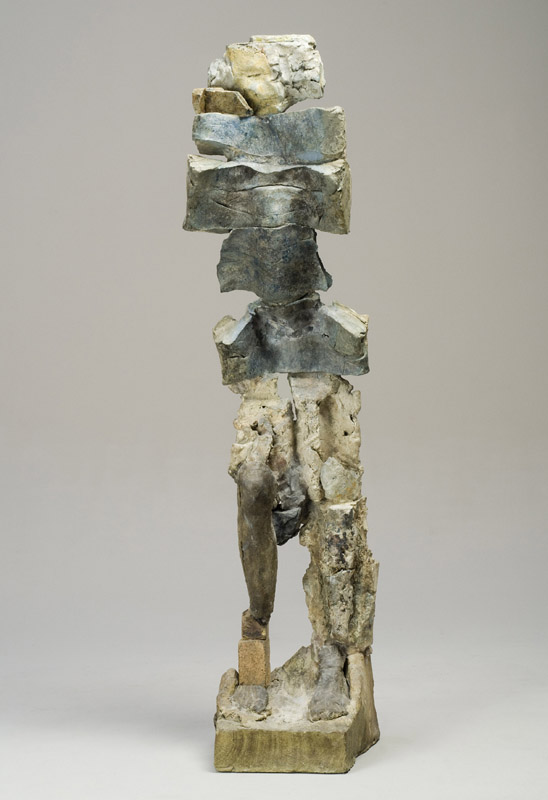by Rob Marks
I once walked into a small gallery under the roof of the Musée Maillol in Paris and found myself surrounded by a dozen of the French artist’s nude women in bronze. The iconic broad-shouldered figures startled me, arrested my movement. It is common in American museums to see one or two Maillols in a room—to be intrigued by their beauty, the power and grace of their form, the intensity of their gaze—but it is rare to be cornered by a posse of them.
Stephen De Staebler’s work is as far from Aristide Maillol’s as Berkeley—De Staebler’s home until his death in 2011—is from the French artist’s Roussillon. Yet the experience of walking into the de Young Museum’s retrospective of De Staebler ceramic figures brought back that startling moment in Paris. They crowd around the viewer, evoking an amalgam of the stillness of a graveyard, the gravity of a procession, the grace of a dance, and, most magically, the sentience of a living thing. Curator Timothy Anglin Burgard writes that De Staebler’s sculptures “focus instead on the transitional or metamorphic states that lie between nature and culture, life and death, integration and disintegration, and matter and spirit." This is a fair statement, but I was aware as much of their persistence and repose as I was of their transitional nature. They are, like the Maillol nudes, self-possessed, self-reliant, and whole.
“Everyone...in one way or another, feels incomplete,” De Staebler proposed. “You could almost say civilization is the attempt to camouflage the fact that we’re incomplete human beings.” Perhaps this is why De Staebler’s incomplete sculptures function as complete. They represent the experience of being embodied in their fragmentation, unfamiliarity, and unknowableness. When De Staebler said, “There is something about the fallibility of the human body that you have to come to terms with,” he meant that his sculptures come not to a resolution but to an understanding, a truce, with embodiment. When he gathered body parts in Thorax Figure (2008), for example, the brick of clay that surmounts the intimations of foot, ankle, calf, knee, and thigh does not merely stand in for a pelvis, it is, with only the merest articulation, pelvic. When, in works like the bronze Winged Woman Walking I (1987), De Staebler cantilevered an appendage from a shoulder, the result suspends all disbelief about both the body and its capacity to fly.
De Staebler’s figures seem utterly original, not in the sense of being unprecedented—I wasn’t surprised to find in Burgard’s essay affirmation that De Staebler drew inspiration from Moore, Giacometti, Rodin, and Egyptian stone pharaohs—but in the impossible sense of their having been the models for these earlier developments. The German philosopher Walter Benjamin said, of translated poetry, that it “must enrich its adoptive tongue as it had changed the linguistic world of its original.” Applying the textures of rock, bone, and skin and the colors of earth, sky, and what seem the remains of ancient polychrome, De Staebler translated not the work of his predecessors but the human figure itself. He returned the body to its original language: the event of living.
Stephen De Staebler | Thorax Figure, 2010 | Bronze | 68 x 17 x 16 inches
MATTER AND SPIRIT: The sculpture of Stephen DeStaebler is on view at the de Young Museum in San Francisco, through May 13, 2012

